Design and Test of a Sliding Cutting Device for the Plastic Mulch Waste
Abstract
1. Introduction
2. Materials and Methods
2.1. Sliding Cutting Device
2.1.1. The Whole Structure of the Sliding Cutting Device
2.1.2. The Transmission Part
2.1.3. Working Principle
2.2. Research on Cutting Part
2.2.1. Structural Design of the Inner Arc Cutter
2.2.2. Structural Analysis of Support Rods
2.2.3. Energy Consumption Analysis with Different Cutting Conditions
2.2.4. Analysis of Cutting and Supporting Rotation Speed Ratio with Effective Cutting
2.3. Test Devices, Methods, and Response Indicators
2.4. Test Scheme
3. Results
3.1. Regression Analysis of Variance and Model Construction
3.2. Analysis of the Influence Law of Single Factor on the Crushing of Waste
3.2.1. Influence Law of Single Factors a, b, and c on Film Breakage Rate y1
3.2.2. Influence Law of Single Factors a, b, and c on Knotted Feature Removal Rate y2
3.3. Influence Law of Significant Interactive Factor on the Crushing of Waste
3.3.1. Influence Law of Significant Interactive Factor on Response Indicator y1
3.3.2. Influence Law of Significant Interactive Factor on Response Indicator y2
- (1)
- Influence law of ac on y2
- (2)
- Influence law of bc on y2
3.4. Optimization of Target Parameters and Experimental Validation
4. Discussion
- (1)
- The test shows that the cutting-support motor speed ratio and the sliding cutter edge angle have a significant impact on the film breakage rate. After analysis, the following can be seen: when the cutting-support motor speed ratio is too small, the phenomenon of missing cutting is serious, so the film breakage rate is too low; when the cutting-support motor speed ratio is too large, the material on the sliding cutter will slide and gather without enough time, resulting in a poor crushing effect; when the sliding cutter edge angle is too large, the force component of the material in the normal direction is too small, and the crushing effect will be poor; when the sliding cutter edge angle is too small, the material will not slip, so the crushing effect will be poor.
- (2)
- The test shows that the support motor rotation speed and the sliding cutter edge angle have a significant influence on the removal rate of the knotted feature. When the support motor rotation speed is fast, the rotation speed of the knotted feature on the support rod is too fast, resulting in an insufficient removal time during the mixing process. When the speed of the support motor is too slow, the material slips on the support rod due to gravity, and it is too late to be crushed. When the angle is too large, the component force of the material in the normal direction is too small, resulting in a poor removal effect of the knotted feature.
- (3)
- The experiment only studies the crushing effects of the film, such as film breakage rate and knotted feature removal rate in the waste, but regarding the entanglement of the waste during the crushing process and the broken film in the air blowing flow. The characteristics of the migration motion under the synergistic effect of the field and the rotational motion still need to be further studied.
- (4)
- For the knotted features of the plastic mulch waste, an inner arc cutter was proposed. Compared with the V-shaped cutter designed in reference [18], the inner arc cutter is more effective in breaking the knotted features of the waste. However, the cutter in reference [18] is more effective for the overall cutting uniformity of the waste. Compared with the water-washing separation in reference [19], the sliding cutting device is more suitable for residual film treatment companies, and the method used in reference [19] has a higher waste of water but a better separation effect.
5. Conclusions
Author Contributions
Funding
Institutional Review Board Statement
Informed Consent Statement
Data Availability Statement
Conflicts of Interest
References
- Hu, Y.; Ma, P.; Duan, C.; Wu, S.; Feng, H.; Zou, Y. Black plastic film combined with straw mulching delays senescence and increases summer maize yield in northwest China. Agric. Water Manag. 2020, 231, 106031. [Google Scholar] [CrossRef]
- Fu, W.; Fan, J.; Hao, M.; Hu, J.; Wang, H. Evaluating the effects of plastic film mulching patterns on cultivation of winter wheat in a dryland cropping system on the Loess Plateau, China. Agric. Water Manag. 2020, 244, 106550. [Google Scholar] [CrossRef]
- Hu, C.; Wang, X.; Wang, S.; Lu, B.; Guo, W.; Liu, C.; Tang, X. Impact of agricultural residual plastic film on the growth and yield of drip-irrigated cotton in arid region of Xinjiang, China. Int. J. Agric. Biol. Eng. 2020, 13, 160–169. [Google Scholar] [CrossRef]
- Wang, Y.P.; Li, X.G.; Zhu, J.; Fan, C.Y.; Kong, X.J.; Turner, N.C.; Siddique, K.H.; Li, F.-M. Multi-site assessment of the effects of plastic-film mulch on dryland maize productivity in semiarid areas in China. Agric. For. Meteorol. 2016, 220, 160–169. [Google Scholar] [CrossRef]
- Thidar, M.; Gong, D.; Mei, X.; Gao, L.; Li, H.; Hao, W.; Gu, F. Mulching improved soil water, root distribution and yield of maize in the Loess Plateau of Northwest China. Agric. Water Manag. 2020, 241, 106340. [Google Scholar] [CrossRef]
- Blöcker, L.; Watson, C.; Wichern, F. Living in the plastic age—Different short-term microbial response to microplastics addition to arable soils with contrasting soil organic matter content and farm management legacy. Environ. Pollut. 2020, 267, 115468. [Google Scholar] [CrossRef]
- Kumar, M.; Xiong, X.; He, M.; Tsang, D.C.; Gupta, J.; Khan, E.; Harrad, S.; Hou, D.; Ok, Y.S.; Bolan, N.S. Microplastics as pollutants in agricultural soils. Environ. Pollut. 2020, 265, 114980. [Google Scholar] [CrossRef] [PubMed]
- Qi, R.; Jones, D.L.; Li, Z.; Liu, Q.; Yan, C. Behavior of microplastics and plastic film residues in the soil environment: A critical review. Sci. Total Environ. 2019, 703, 134722. [Google Scholar] [CrossRef]
- Steinmetz, Z.; Wollmann, C.; Schaefer, M.; Buchmann, C.; David, J.; Tröger, J.; Muñoz, K.; Frör, O.; Schaumann, G.E. Plastic mulching in agriculture. Trading short-term agronomic benefits for long-term soil degradation? Sci. Total Environ. 2016, 550, 690–705. [Google Scholar] [CrossRef]
- Jiang, X.J.; Liu, W.; Wang, E.; Zhou, T.; Xin, P. Residual plastic mulch fragments effects on soil physical properties and water flow behavior in the Minqin Oasis, northwestern China. Soil Tillage Res. 2017, 166, 100–107. [Google Scholar] [CrossRef]
- Zhang, G.S.; Liu, Y.F. The distribution of microplastics in soil aggregate fractions in southwestern China. Sci. Total Environ. 2018, 642, 12–20. [Google Scholar] [CrossRef]
- Zhang, Y.; Zhang, J.; Li, S.; Zhang, Y.; Li, H. Research Status and Prospect of Residual Plastic Film Pickup Mechanism in China. J. Phys. Conf. Ser. 2021, 1798, 012029. [Google Scholar] [CrossRef]
- Wang, P.; Chen, X.; Wen, H. Research and Experiment on the Removal Mechanism of Light Impurities of the Residual Mulch Film Recovery Machine. Agriculture 2022, 12, 775. [Google Scholar] [CrossRef]
- Jin, W.; Liu, J.; Xu, C.; Zhang, X.; Bai, S. Design, Simulation and Experimentation of a Polythene Film Debris Recovery Machine in Soil. Appl. Sci. 2022, 12, 1366. [Google Scholar] [CrossRef]
- Yang, S.; Chen, X.; Yan, L.; Jiang, D. Performance of Three DifferentSpades for Residual Plastic Film Recycling Machine. Appl. Eng. Agric. 2020, 36, 187–195. [Google Scholar] [CrossRef]
- Liang, R.; Chen, C.; Zhang, B. Problems and countermeasures of recycling methods and resource reuse of residual film in cotton fields of Xinjiang. Trans. Chin. Soc. Agric. Eng. 2019, 35, 1–13. [Google Scholar] [CrossRef]
- He, H.; Hu, B.; Li, J.; Cai, H.; Luo, X. Research and Experiment of the Machine Collecting Residual Film in the Impeller—Driven Washing Separation Device. Agric. Mech. Res. 2020, 9, 151–155. [Google Scholar]
- Pan, F.; Hu, B.; Luo, X.; Guo, M.; He, H. Design and Testing of a Shearing and Breaking Device for Mulch Film and Cotton Stalk Mixtures. Trans. ASABE 2021, 64, 545–555. [Google Scholar] [CrossRef]
- He, H.; Hu, B.; Pan, F.; Luo, X.; Guo, M.; Xie, Y.; Chen, X. Effects and experiment on settlement and aggregation behavior of plastic film and cotton stalk under the action of disturbing water by the impeller. Trans. Chin. Soc. Agric. Eng. 2021, 37, 86–95. [Google Scholar] [CrossRef]
- Sica, C.; Dimitrijević, A.; Scarascia-Mugnozza, G.; Picuno, P. Technical Properties of Regenerated Plastic Material Bars Produced from Recycled Agricultural Plastic Film. Polym. Technol. Eng. 2015, 54, 1207–1214. [Google Scholar] [CrossRef]
- Simpson, A. Reclaimed fibres, the source and usage. In Recycling Textile and Plastic Waste; Elsevier: Amsterdam, The Netherlands, 1996; pp. 33–41. [Google Scholar] [CrossRef]
- Geisseler, D.; Joergensen, R.G.; Ludwig, B. Temporal effect of straw addition on amino acid utilization by soil microor-ganisms. Eur. J. Soil Biol. 2012, 53, 107–113. [Google Scholar] [CrossRef]
- Li, P.; He, C.; Li, G.; Ding, P.; Lan, M.; Gao, Z.; Jiao, Y. Biological pretreatment of corn straw for enhancing degradation efficiency and biogas production. Bioengineered 2020, 11, 251–260. [Google Scholar] [CrossRef]
- Goodman, B.A. Utilization of waste straw and husks from rice production: A review. J. Bioresour. Bioprod. 2020, 5, 143–162. [Google Scholar] [CrossRef]
- Abraham, A.; Mathew, A.K.; Sindhu, R.; Pandey, A.; Binod, P. Potential of rice straw for bio-refining: An overview. Bioresour. Technol. 2016, 215, 29–36. [Google Scholar] [CrossRef] [PubMed]
- Ge, Z.H.; Si, D.G.; Lan, Y.L.; Shi, M.N. The Effect of Modifying Agents on the Mechanical Properties of Straw Flour/Waste Plastic Composite Materials. Key Eng. Mater. 2016, 723, 56–61. [Google Scholar] [CrossRef]
- Tang, Z.; Liang, Y.; Wang, M.; Zhang, H.; Wang, X. Effect of mechanical properties of rice stem and its fiber on the strength of straw rope. Ind. Crop. Prod. 2022, 180, 114729. [Google Scholar] [CrossRef]
- Guo, W.; Hu, C.; He, X.; Wang, L.; Hou, S.; Wang, X. Construction of virtual mulch film model based on discrete element method and simulation of its physical mechanical properties. Int. J. Agric. Biol. Eng. 2020, 13, 211–218. [Google Scholar] [CrossRef]
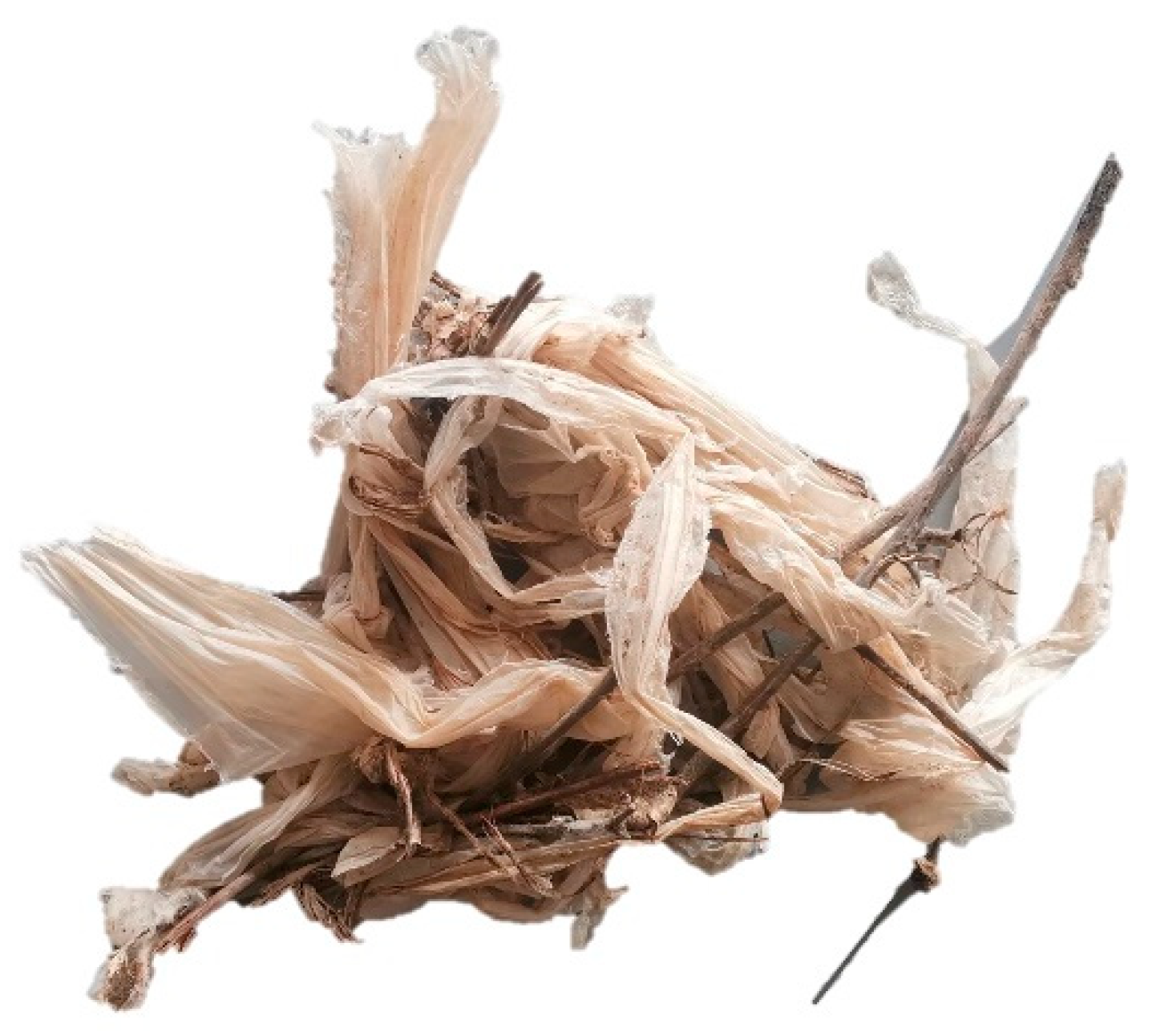
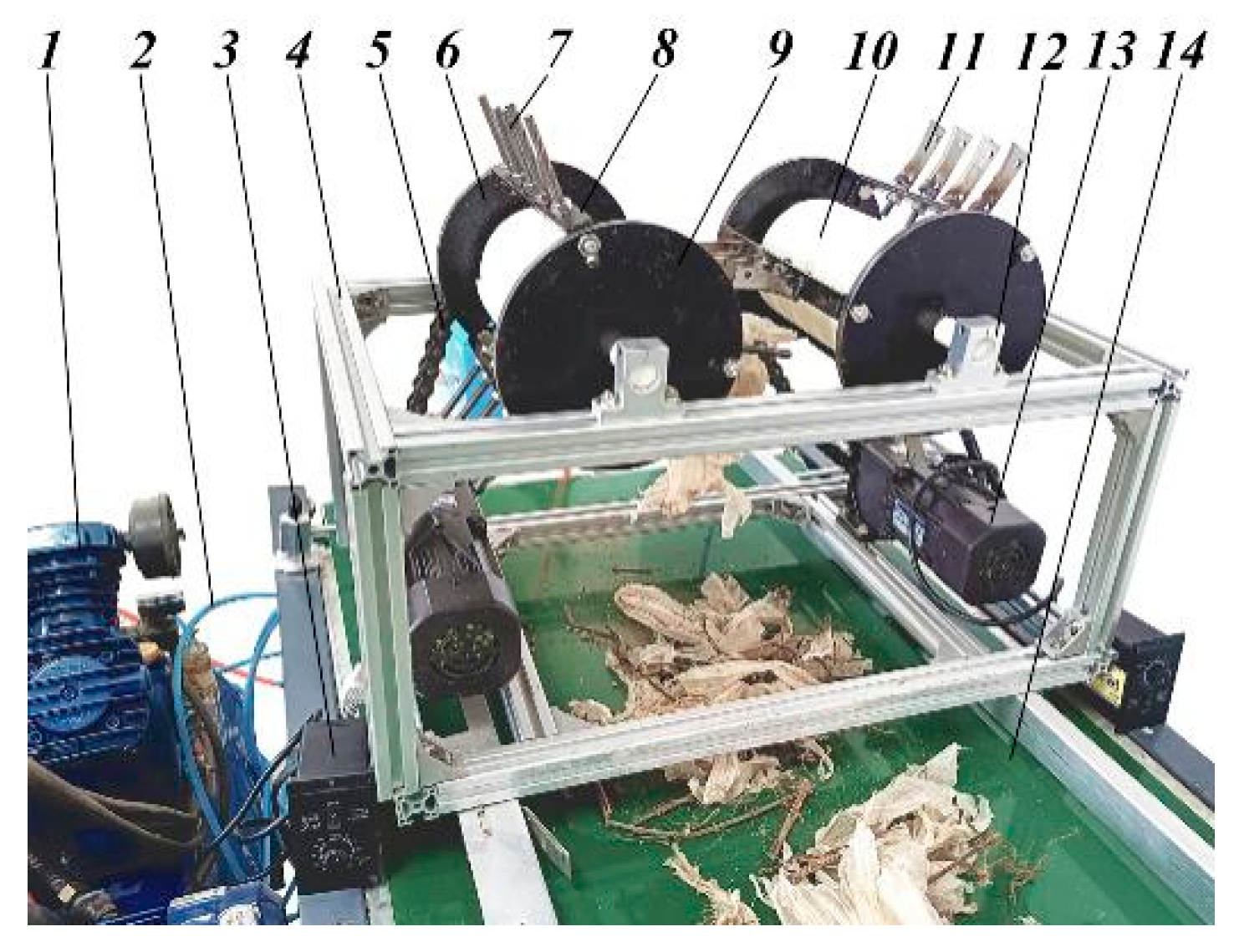


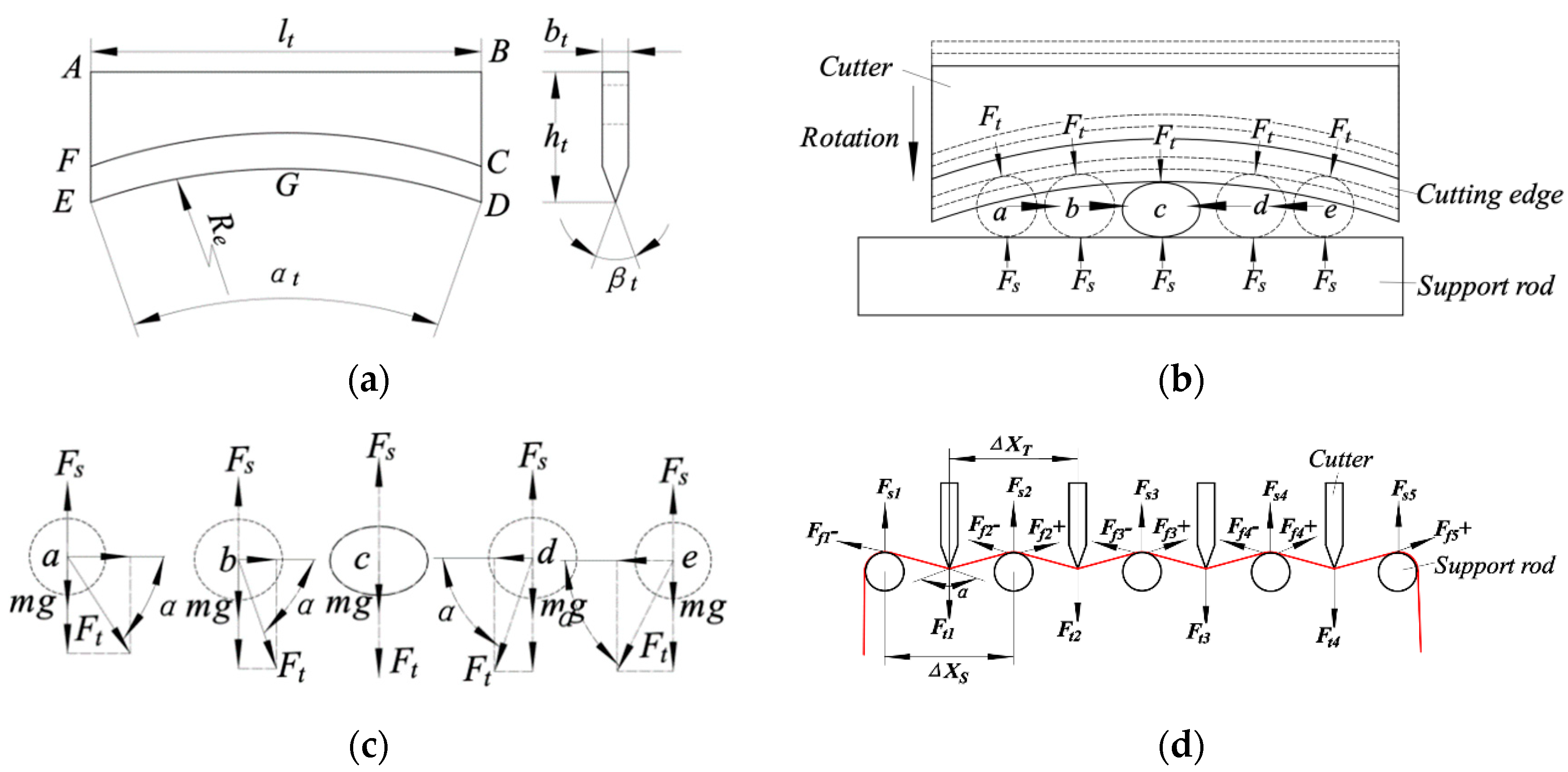


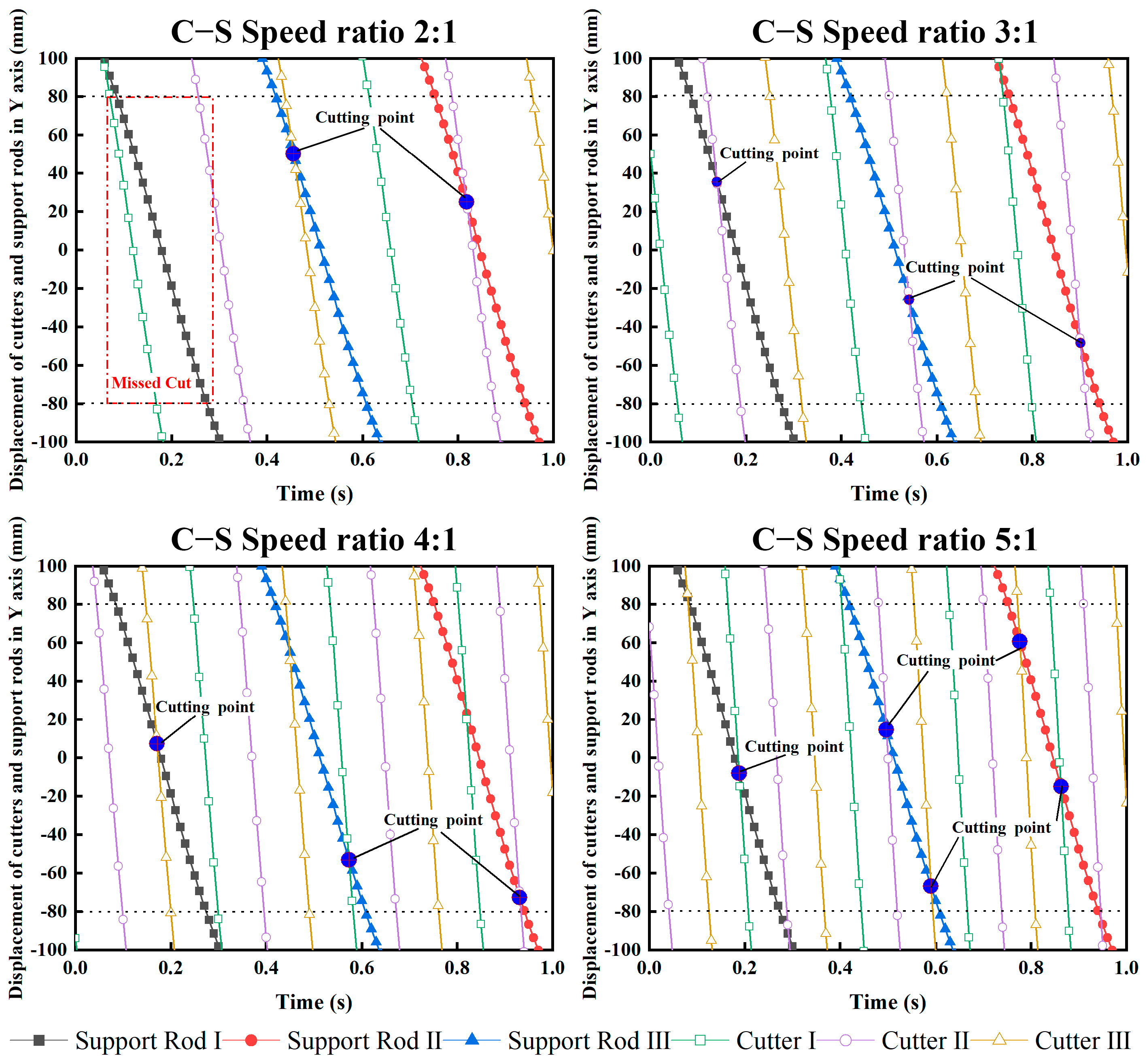
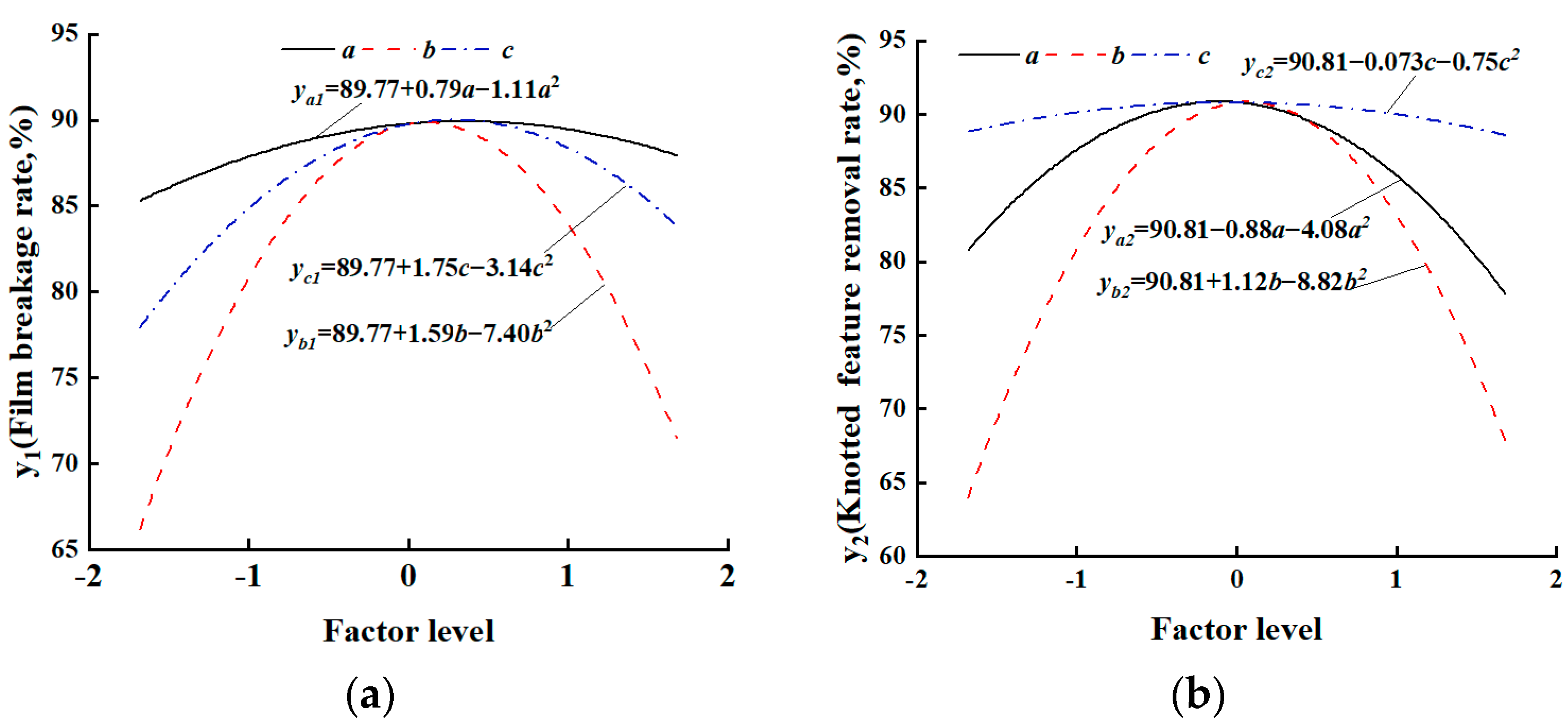

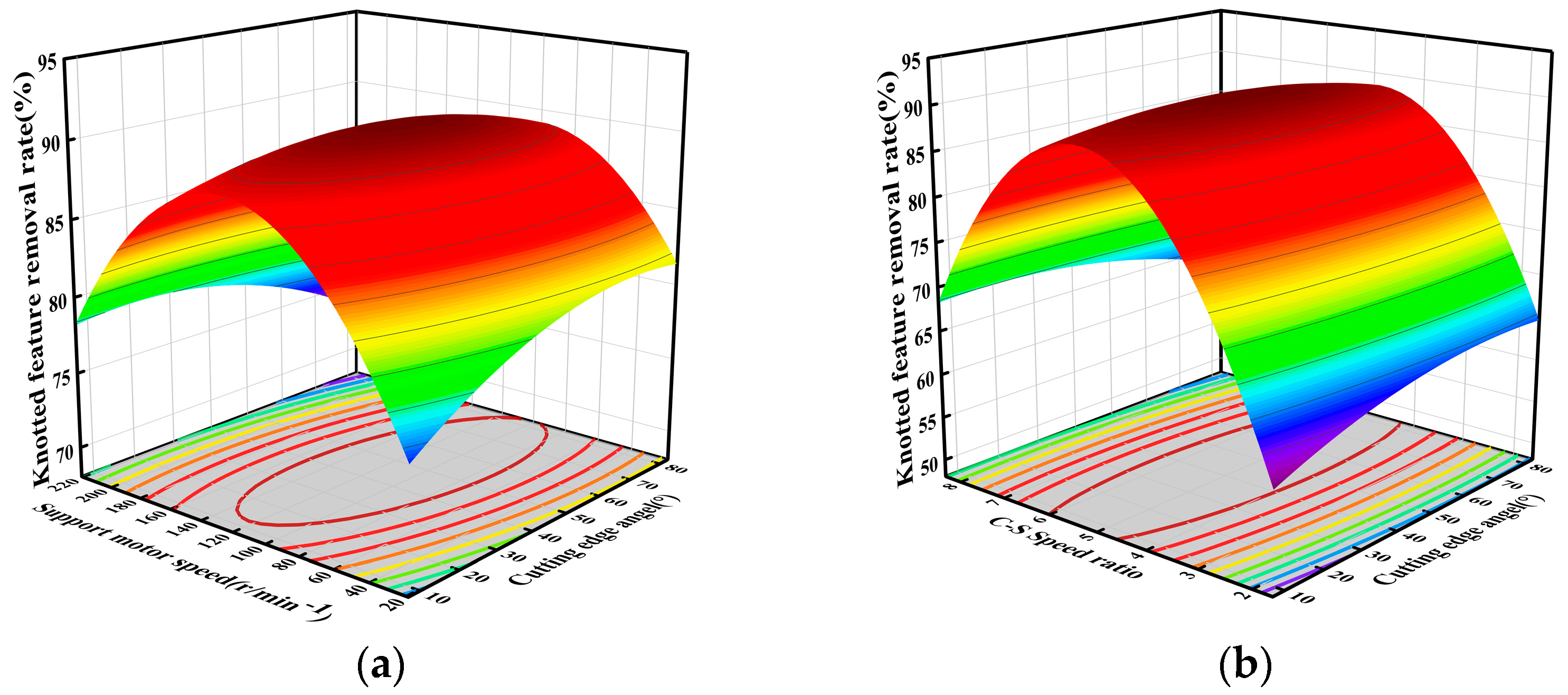
| S/N | a (r·min−1) | b | c (°) | y1 (%) | y2 (%) |
|---|---|---|---|---|---|
| 1 | −1 (60) | −1 (3) | −1 (22.5) | 76.8 | 74.1 |
| 2 | 1 (180) | −1 | −1 | 78.3 | 75.3 |
| 3 | −1 | 1 (7) | −1 | 70.3 | 80.0 |
| 4 | 1 | 1 | −1 | 72.4 | 78.9 |
| 5 | −1 | −1 | 1 (67.5) | 72.1 | 77.1 |
| 6 | 1 | −1 | 1 | 73.1 | 75.3 |
| 7 | −1 | 1 | 1 | 84.6 | 79.9 |
| 8 | 1 | 1 | 1 | 86.7 | 74.3 |
| 9 | −1.682 (19.09) | 0 (5) | 0 | 87.3 | 81.1 |
| 10 | 1.682 (220.91) | 0 | 0 | 89.7 | 78.3 |
| 11 | 0 (120) | −1.682 (1.64) | 0 (45) | 68.3 | 65.1 |
| 12 | 0 | 1.682 (8.36) | 0 | 73.1 | 67.5 |
| 13 | 0 | 0 | −1.682 (7.16) | 81.2 | 88.3 |
| 14 | 0 | 0 | 1.682 (82.84) | 84.3 | 89.9 |
| 15 | 0 | 0 | 0 | 89.3 | 90.3 |
| 16 | 0 | 0 | 0 | 90.4 | 91.2 |
| 17 | 0 | 0 | 0 | 88.2 | 89.3 |
| 18 | 0 | 0 | 0 | 89.1 | 92.6 |
| 19 | 0 | 0 | 0 | 91.2 | 90.5 |
| Source | y1 | y2 | ||
|---|---|---|---|---|
| F-Value | p-Value | F-Value | p-Value | |
| Model | 22.65 | <0.0001 ** | 108.79 | <0.0001 ** |
| a | 1.60 | 0.2383 | 8.43 | 0.0175 * |
| b | 6.56 | 0.0306 * | 13.74 | 0.0049 ** |
| c | 7.91 | 0.0203 * | 0.057 | 0.8161 |
| ab | 0.068 | 0.7997 | 3.71 | 0.0862 |
| ac | 5.907 × 10 −3 | 0.9404 | 5.61 | 0.0420 * |
| bc | 35.02 | 0.0002 ** | 5.91 | 0.0379 * |
| a2 | 3.18 | 0.1082 | 181.08 | <0.0001 ** |
| b2 | 141.42 | <0.0001 ** | 846.30 | <0.0001 ** |
| c2 | 25.49 | 0.0007 ** | 6.19 | 0.0345 * |
| Lack of Fit | 6.14 | 0.0516 | 0.71 | 0.6492 |
| R2 = 0.9577 | R2 = 0.9909 | |||
| R2adj = 0.9154 | R2adj = 0.9818 | |||
| C.V. = 2.83% | C.V. = 1.38% | |||
Disclaimer/Publisher’s Note: The statements, opinions and data contained in all publications are solely those of the individual author(s) and contributor(s) and not of MDPI and/or the editor(s). MDPI and/or the editor(s) disclaim responsibility for any injury to people or property resulting from any ideas, methods, instructions or products referred to in the content. |
© 2023 by the authors. Licensee MDPI, Basel, Switzerland. This article is an open access article distributed under the terms and conditions of the Creative Commons Attribution (CC BY) license (https://creativecommons.org/licenses/by/4.0/).
Share and Cite
Guo, M.; Hu, B.; Luo, X.; Yuan, C.; Cai, Y.; Xu, L. Design and Test of a Sliding Cutting Device for the Plastic Mulch Waste. Sustainability 2023, 15, 4513. https://doi.org/10.3390/su15054513
Guo M, Hu B, Luo X, Yuan C, Cai Y, Xu L. Design and Test of a Sliding Cutting Device for the Plastic Mulch Waste. Sustainability. 2023; 15(5):4513. https://doi.org/10.3390/su15054513
Chicago/Turabian StyleGuo, Mengyu, Bin Hu, Xin Luo, Chenglin Yuan, Yiquan Cai, and Luochuan Xu. 2023. "Design and Test of a Sliding Cutting Device for the Plastic Mulch Waste" Sustainability 15, no. 5: 4513. https://doi.org/10.3390/su15054513
APA StyleGuo, M., Hu, B., Luo, X., Yuan, C., Cai, Y., & Xu, L. (2023). Design and Test of a Sliding Cutting Device for the Plastic Mulch Waste. Sustainability, 15(5), 4513. https://doi.org/10.3390/su15054513






